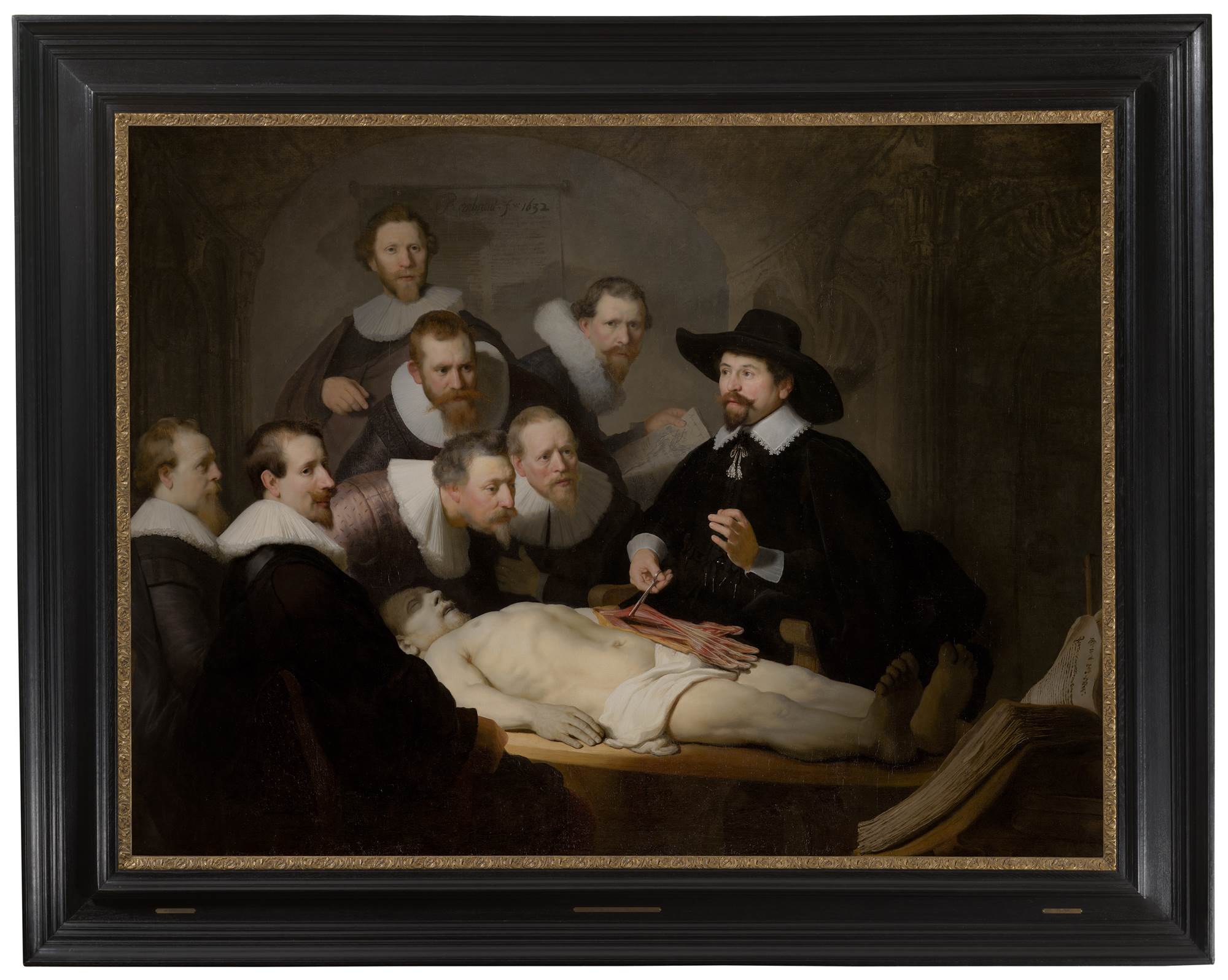The Anatomy Lesson of Dr Nicolaes Tulp is one of Rembrandt’s most impressive group portraits. The painting was made in 1632, shortly after the artist’s move from the town of Leiden to Amsterdam. The surgeons’ prestigious commission provided a unique opportunity to become known among art-lovers’ circles in Amsterdam, and the painter did not allow this chance to pass. The painting firmly established Rembrandt’s name as a portraitist.
Anatomy demonstrations were held in Amsterdam from 1555 onwards. They were organised by the surgeons’ guild and in Rembrandt’s day they were held in an anatomy theatre in De Waag, Amsterdam’s weighing house. The praelector or overseer of the guild would lecture, while the public – anatomy students and laypeople alike – could watch for a fee. Anatomy lessons might last for days: the abdominal cavity and the perishable bowels would be dissected first, followed by the head and limbs. To minimise the stench, the classes were taught in the cold winter months.
Every few years a painter was commissioned to produce an anatomy piece to commemorate one of these demonstrations, perhaps following the appointment of a new praelector or the enrolment of several new members. Nicolaes Tulp (1593-1674) was appointed praelector in 1628, in which capacity he gave nine public lectures between 1631 and 1650. In 1632 he had himself immortalised together with a few guild members who contributed towards the fee. The body made available for this event was that of Adriaen Adriaensz, also known as Aris Kindt, a confirmed criminal who had been sentenced to death for robbery and hanged.
Rembrandt had undoubtedly seen how his predecessors had depicted these demonstrations, since in 1632 there were three anatomy pieces (dating from 1603, 1619 and 1625) hanging in the guild’s offices. Rembrandt’s group portrait is far more dynamic than any of them. He moved away from the customary horizontal, rather static grouping of the surgeons and opted for a pyramidal arrangement in which the lecturer Tulp occupies the entire right half of the scene while the doctors watching the demonstration take up the left half. He also decided to abandon the custom of having the sitters gaze straight out of the picture at the viewers. Instead, each guild member focuses his gaze on a different point inside or outside the picture frame, creating a far livelier composition. The man bending over forwards is a brilliant invention, which introduces still more movement into the group and subtly emphasises the physicians’ concentrated attention.
Nicolaes Tulp is in many respects the most important man in this portrait. This is immediately obvious to the viewers from his prominent position, which is emphasised by the niche with the shell-shaped crowning element behind his back, creating the impression that he is seated on a throne. He is also the only man wearing a hat. Initially the surgeon seen at the top of the painting, Frans van Loenen, also wore a hat, but Rembrandt painted it out – at Tulp’s request, perhaps? A vague shadow where this hat originally appeared recalls this alteration. It must certainly have been Tulp’s choice to be depicted while starting the dissection by opening up an arm and a hand – in other words, departing from customary practice. The frontispiece of a standard work on human anatomy, De humani corporis fabrica (1543) by the German anatomist Andreas Vesalius (1514-1564), contains a portrait of the author holding a dissected arm. It is tempting to conjecture that Tulp may have wanted to emulate his illustrious predecessor and therefore asked Rembrandt to portray him while working on an arm.
The right hand of Aris Kindt’s body exhibits a slight discoloration relative to the rest of the body. X-radiograph examination of the painting has revealed that Rembrandt originally painted only a stump instead of a hand. Aris Kindt, an inveterate thief, undoubtedly lost this hand as a result of a previous conviction. One can easily imagine that either Tulp or Rembrandt, feeling that a stump in this prominent place would attract too much attention, decided to add the hand. Since Rembrandt had not taken the hand into account in the structure of the underlying paint layers, and since the upper layers have become more transparent over the years, the hand is now a slightly different colour from the arm. We may note that Rembrandt’s initial inclusion of the stump shows that he had attended the anatomy demonstration.
Although the painting is nowadays regarded primarily, of course, as an important and superb work of art, it must also have possessed a certain documentary value for the governors of Amsterdam’s surgeons’ guild. Perhaps that is why each sitter was numbered at the beginning of the eighteenth century, and the numbers together with the appropriate names were painted on the paper that one of the surgeons, Hartman Hartmansz, is holding up. That later addition was partly reversed during a recent restoration. The overpaintings have been removed from the sheet of paper, so that the drawing of an arm as originally painted by Rembrandt is now visible again. The numbers beside the sitters have been left intact, however, as a memento of a past age.
(this is a reworked version of a text published in in: P. van der Ploeg, Q. Buvelot, Royal Picture Gallery Mauritshuis: A princely collection, The Hague 2005, pp. 146-148)









